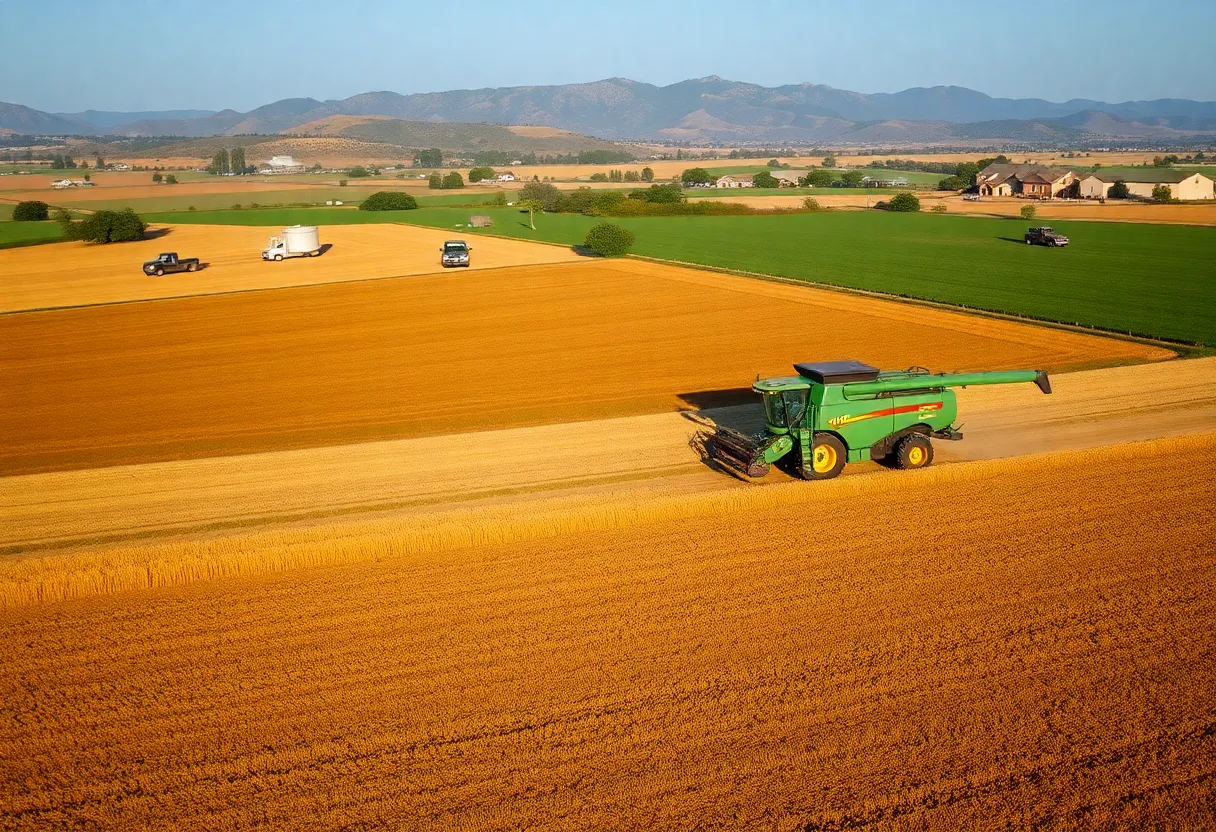California, August 26, 2025
News Summary
California farmers are confronting a severe labor crisis exacerbated by recent immigration raids that leave fields unstaffed. Over 88,000 agricultural jobs remain unfilled annually, prompting a shift towards automation as farmers like Larry Jacobs adopt robotics to reduce their reliance on human labor. However, existing regulations limit the use of autonomous machinery, hindering broader adoption. With the average age of farmers reaching 58, the industry must consider how to attract younger agriculturalists. The situation is further complicated by concerns over immigration policies that could affect agricultural productivity and workforce availability.
California Farmers Face Labor Crisis Amid Immigration Raids and Push for Automation
California farmers are struggling with a growing labor crisis in the wake of recent immigration raids, leaving many fields unstaffed and prompting a significant shift toward automation. The situation has led to nearly 88,000 agricultural jobs remaining unfilled each year in the U.S., reflecting the challenge of sourcing sufficient seasonal labor.
Farmers like Larry Jacobs, who operates in Central California, have reported severe difficulties in finding enough workers to tend to their crops. In response, Jacobs is turning to robotics and technology to maintain his operations, notably reducing his need for human labor by employing autonomous machines. This innovative approach allows Jacobs to maintain his farm with half the human workforce he previously required.
Despite Jacobs’ efforts to modernize, current California state regulations limit the use of autonomous machinery without human oversight, hindering broader adoption of these technologies. Experts, including Tyler Niday, the CEO of Bonsai Robotics, echo this sentiment, emphasizing that many regulations governing autonomous machines were established in the 1970s and require substantial revisions to keep pace with today’s agricultural realities.
Additionally, the average age of farmers in the U.S. has reached 58, raising concerns about attracting a new generation of agriculturalists. Many in the industry believe automation could serve as a key to rejuvenating interest in farming among younger individuals.
The cost of robotics presents a compelling case for automation. Machines developed by Bonsai Robotics are priced around $13,000, significantly lower than traditional full-sized tractors that can cost up to $80,000. This cost-effective solution could make automation more accessible to farmers seeking to mitigate labor shortages.
The labor crisis has intensified following recent immigration enforcement actions. Reports indicate at least 35 arrests took place on Ventura County farms, leading to heightened fear among the existing workforce, many of whom are now hesitant to report for work. In response to this significant labor shortage, U.S. Agriculture Secretary Brooke Rollins has highlighted that the administration is prioritizing automation and reforming existing laws to ease the process of integrating technology into farming.
However, Rollins’ suggestion to recruit able-bodied adults on Medicaid as potential replacements for the migrant workforce has been met with criticism from California’s agricultural industry, particularly from farmers who view these comments as misguided and uninformed. The prevailing statistic indicates that 42% of U.S. crop farmworkers lack work authorization, with California having the highest proportion of unauthorized workers.
The fears stemming from immigration raids have prompted many farmers to report that workers are staying home due to concerns about potential arrests. At the same time, Rollins acknowledged the delicate balance between necessary immigration enforcement and maintaining the food supply.
Critics of the reliance on automation stress that many agricultural tasks still require human expertise, particularly when it comes to picking delicate crops like strawberries. Historical attempts to fill agricultural vacancies with welfare recipients in states like Georgia and Alabama resulted in notable failures, raising skepticism about the viability of replacing migrant workers with automation or other labor sources.
With ongoing open discussions regarding the relationship between food security and national policy, some experts assert that current immigration policies could jeopardize agricultural productivity. The Trump administration has already initiated requests to introduce foreign workers under temporary visa programs to support the agricultural labor force. Meanwhile, ongoing dialogue about the need to legalize essential migrant workers remains an area of concern across the industry.
Summary of Key Issues
- Labor shortages affecting California farms.
- Increasing reliance on automation amid immigration enforcement actions.
- Criticism of proposals to replace migrant workers with Medicaid participants.
- Need for reform in regulations governing autonomous farming machinery.
FAQs
- What are the main challenges California farmers are facing today?
- Farmers are grappling with labor shortages due to immigration raids, leading to unfilled agricultural jobs and a push for automation.
- How has automation been perceived in the agricultural community?
- While automation offers potential solutions to labor shortages, some argue that many agricultural tasks require human labor, making complete automation impractical.
- What is the government’s stance on immigration and the agricultural workforce?
- The government is focusing on both automation and reforming immigration policies, yet proposes to source labor from non-traditional avenues has been controversial.
Key Features of the Labor Crisis in Agriculture
| Feature | Description |
|---|---|
| Labor Shortages | Almost 88,000 agricultural jobs go unfilled annually in the U.S. |
| Automation Adoption | Farmers are increasingly using robots to cope with labor shortages. |
| Cost of Technology | Robotics costing around $13,000 offer a more affordable alternative to tractors at $80,000. |
| Regulatory Challenges | Current laws restrict the use of autonomous farming machines. |
| Demographics | The average age of farmers is 58, impacting future workforce availability. |
| Immigration Impact | 42% of U.S. crop farmworkers lack work authorization, with fear of deportation affecting workforce availability. |
Deeper Dive: News & Info About This Topic
- Los Angeles Times: Trump Administration’s Stance on Farmworker Amnesty
- Wikipedia: Immigration in the United States
- Farmonaut: California’s Agricultural Labor Crisis
- Google Search: California Agricultural Labor Crisis
- Future Farming: Agricultural Robotics Market Growth
- Encyclopedia Britannica: Agricultural Robot
- CBS News: Farming Automation and Migrant Workers
- Google Scholar: Agricultural Automation
- The Guardian: Migrant Farm Workers and Medicaid
- Google News: Migrant Farm Workers California

Author: STAFF HERE COSTA MESA WRITER
The COSTA MESA STAFF WRITER represents the experienced team at HERECostaMesa.com, your go-to source for actionable local news and information in Costa Mesa, Orange County, and beyond. Specializing in "news you can use," we cover essential topics like product reviews for personal and business needs, local business directories, politics, real estate trends, neighborhood insights, and state news affecting the area—with deep expertise drawn from years of dedicated reporting and strong community input, including local press releases and business updates. We deliver top reporting on high-value events such as the OC Fair, Concerts in the Park, and Fish Fry. Our coverage extends to key organizations like the Costa Mesa Chamber of Commerce and Boys & Girls Clubs of Central Orange Coast, plus leading businesses in retail, fashion, and technology that power the local economy such as Vans, Experian, and South Coast Plaza. As part of the broader HERE network, including HEREAnaheim.com, HEREBeverlyHills.com, HERECoronado.com, HEREHollywood.com, HEREHuntingtonBeach.com, HERELongBeach.com, HERELosAngeles.com, HEREMissionViejo.com, HERESanDiego.com, and HERESantaAna.com, we provide comprehensive, credible insights into California's dynamic landscape.





